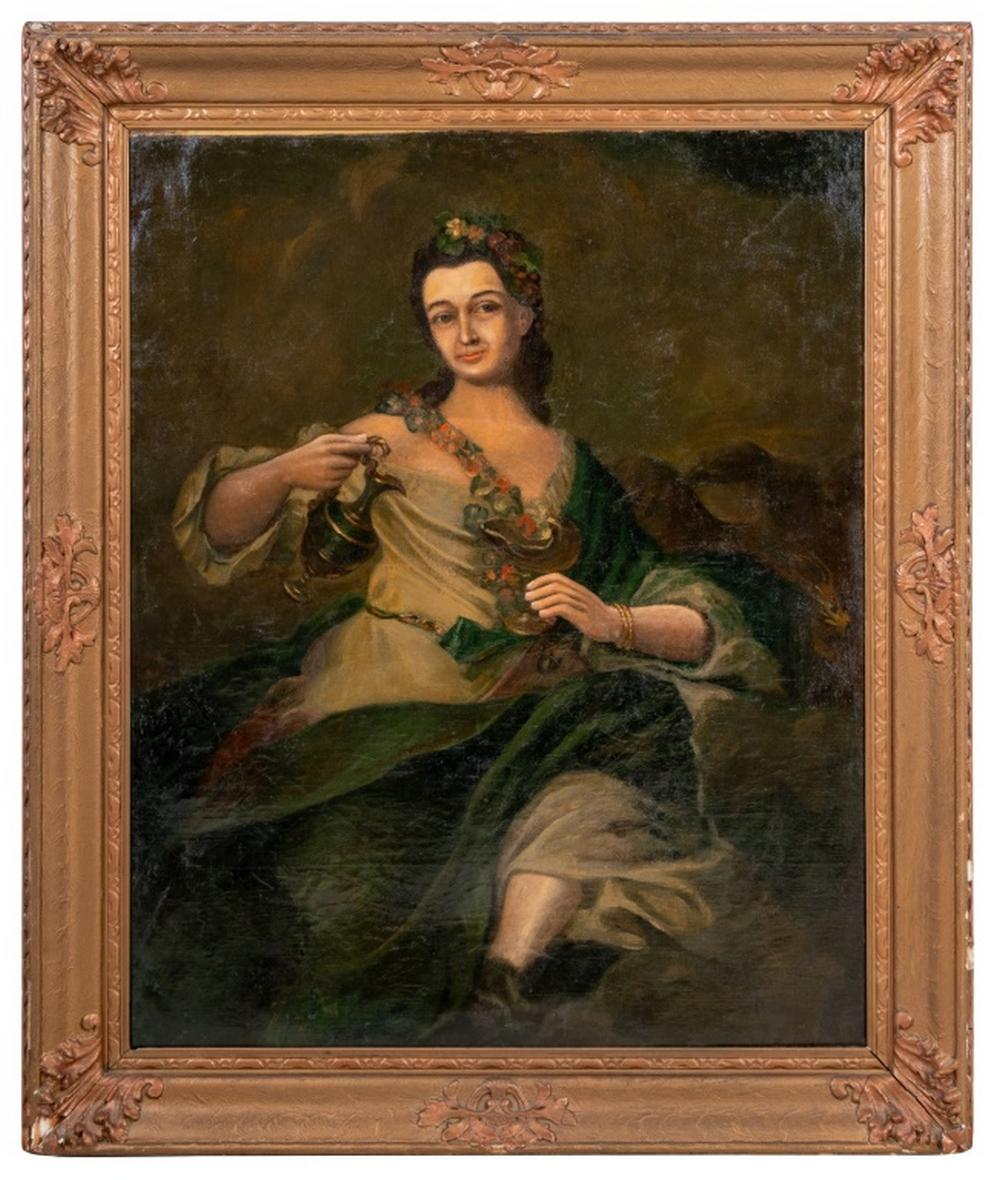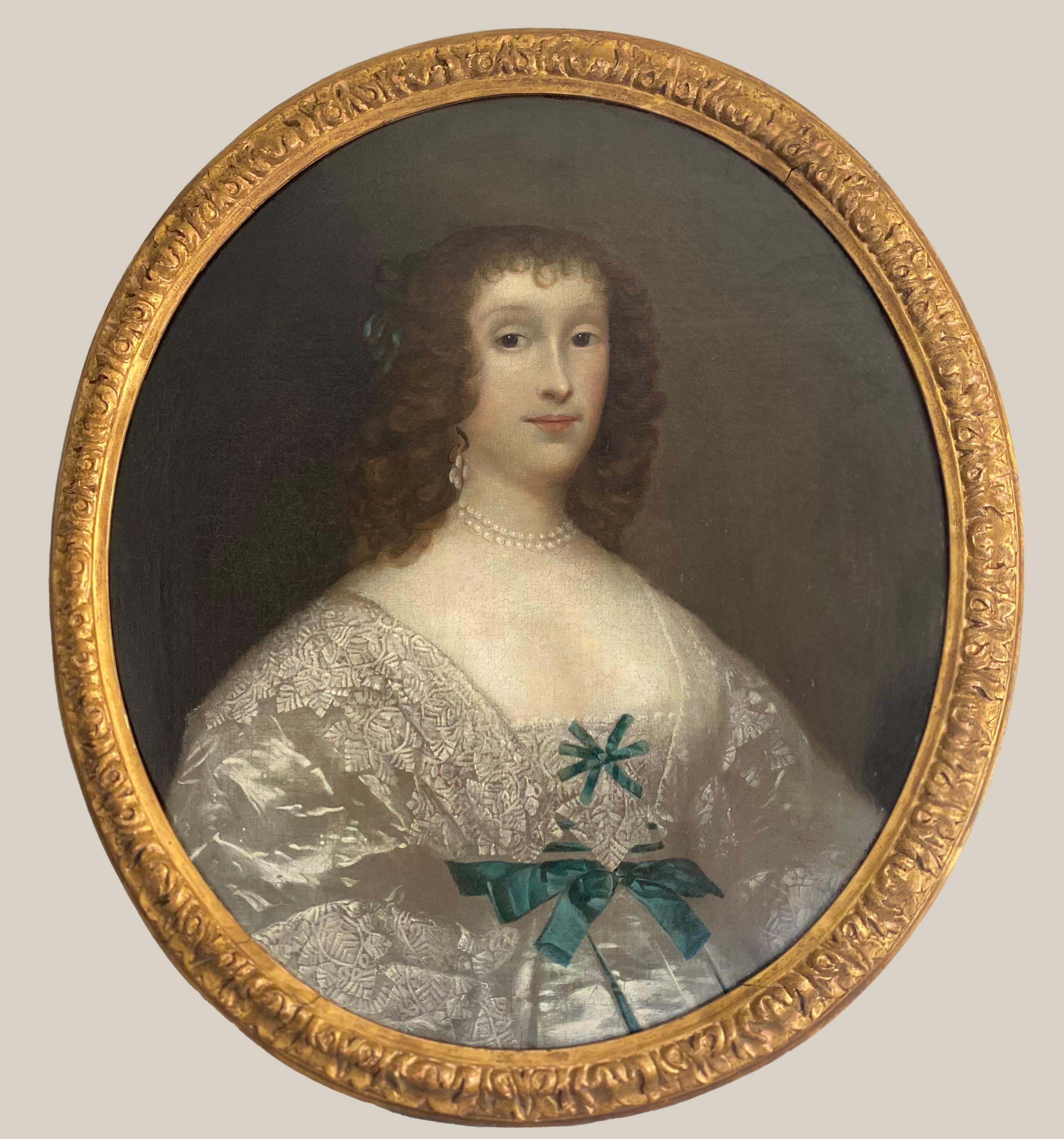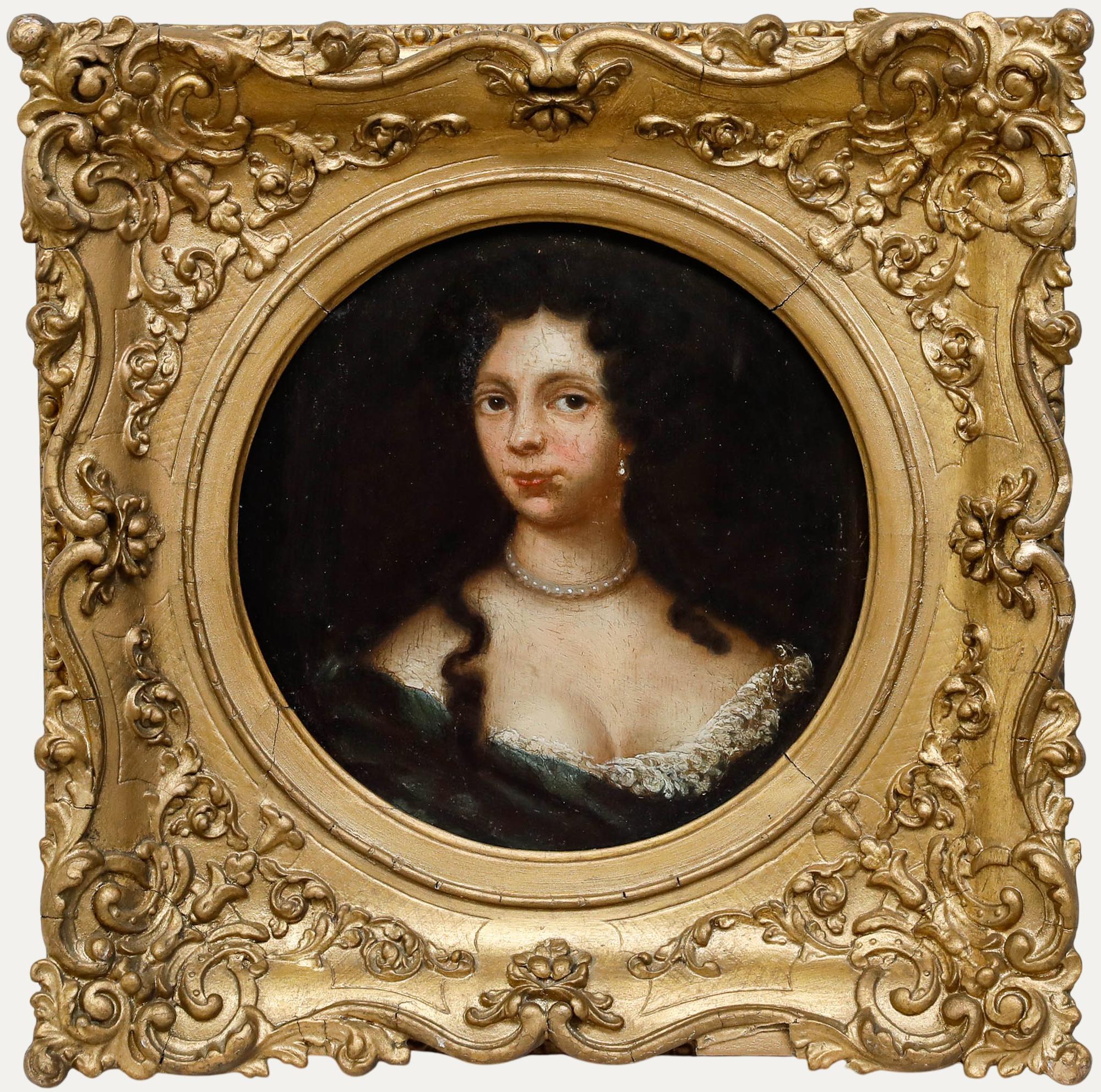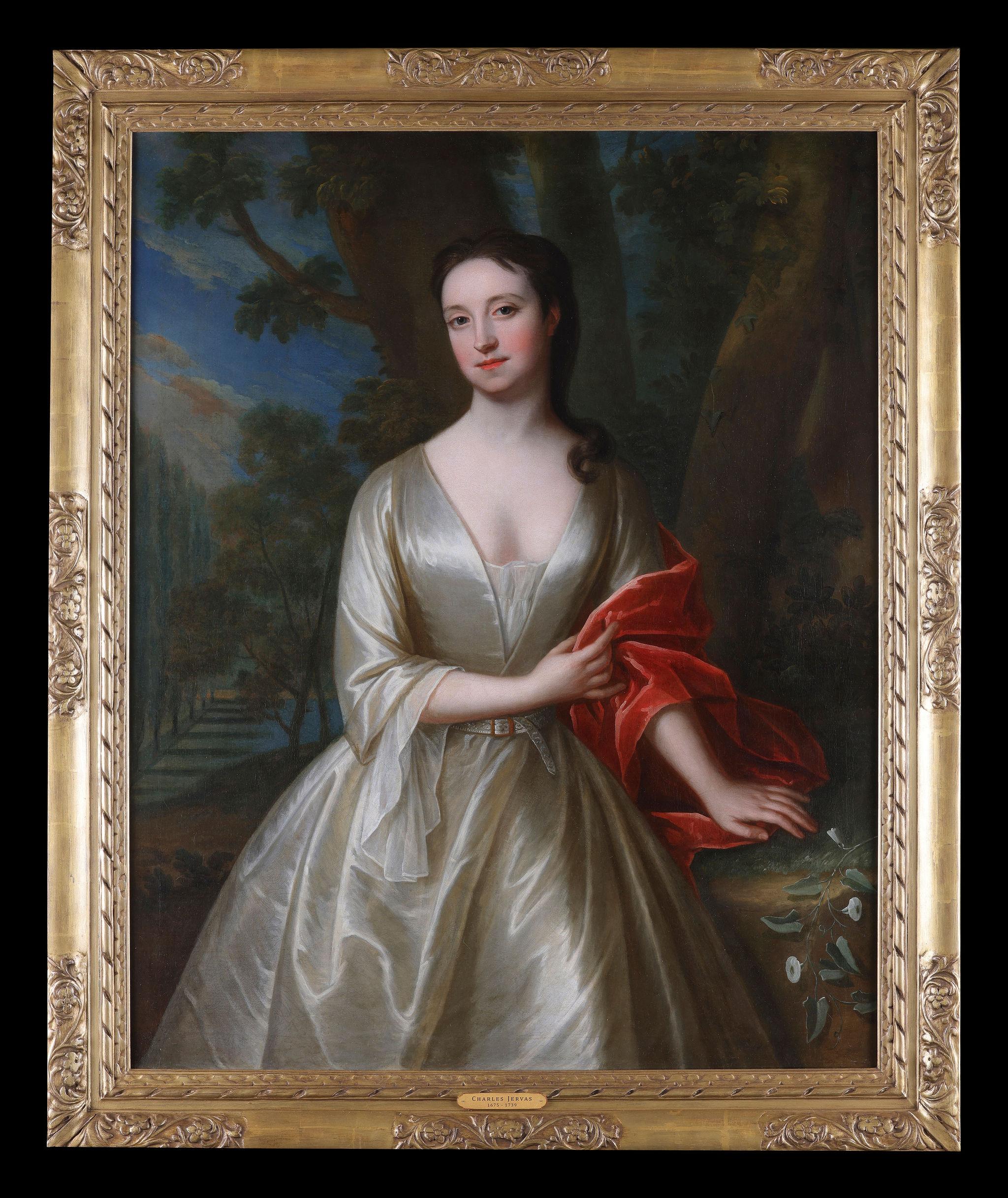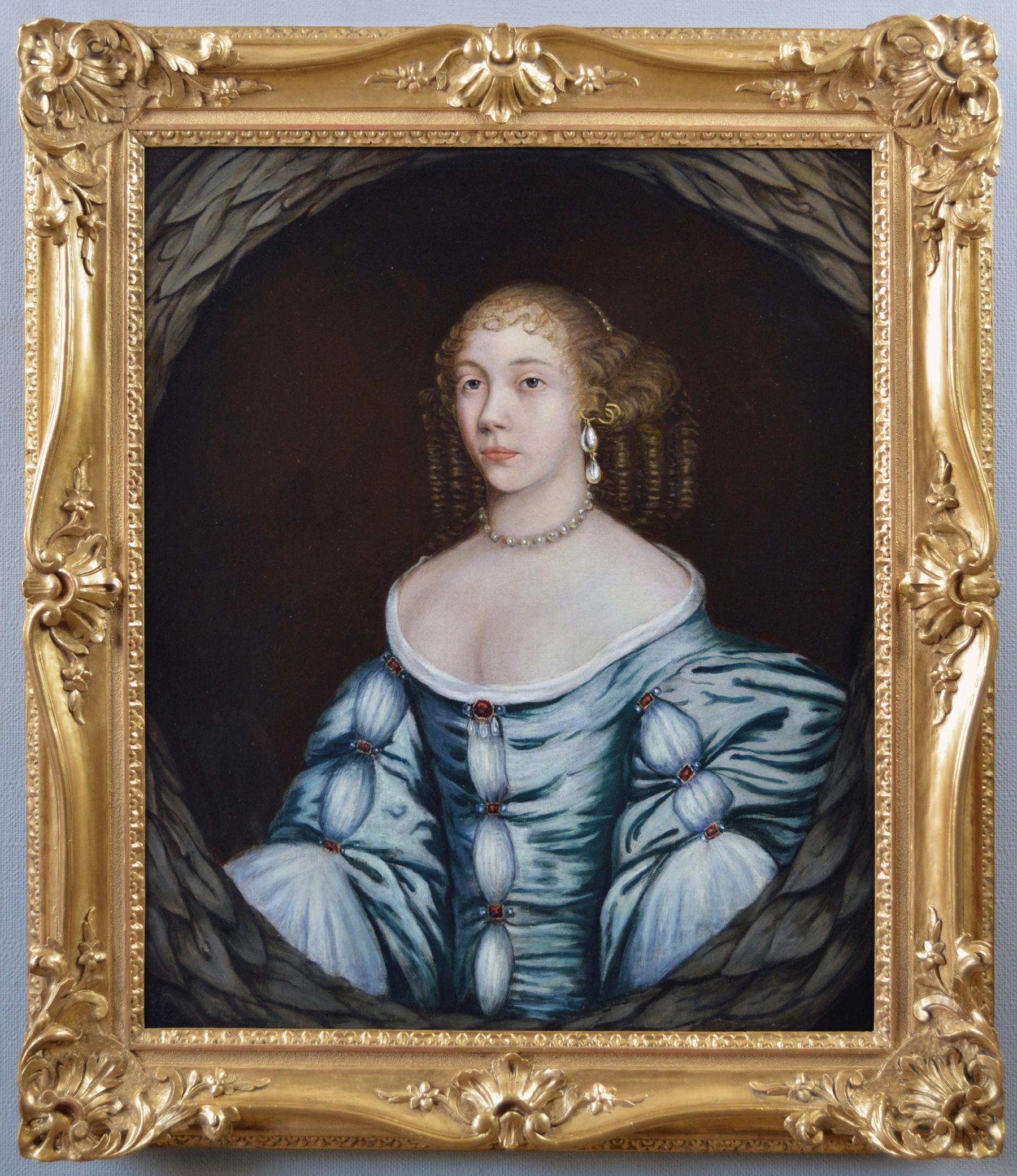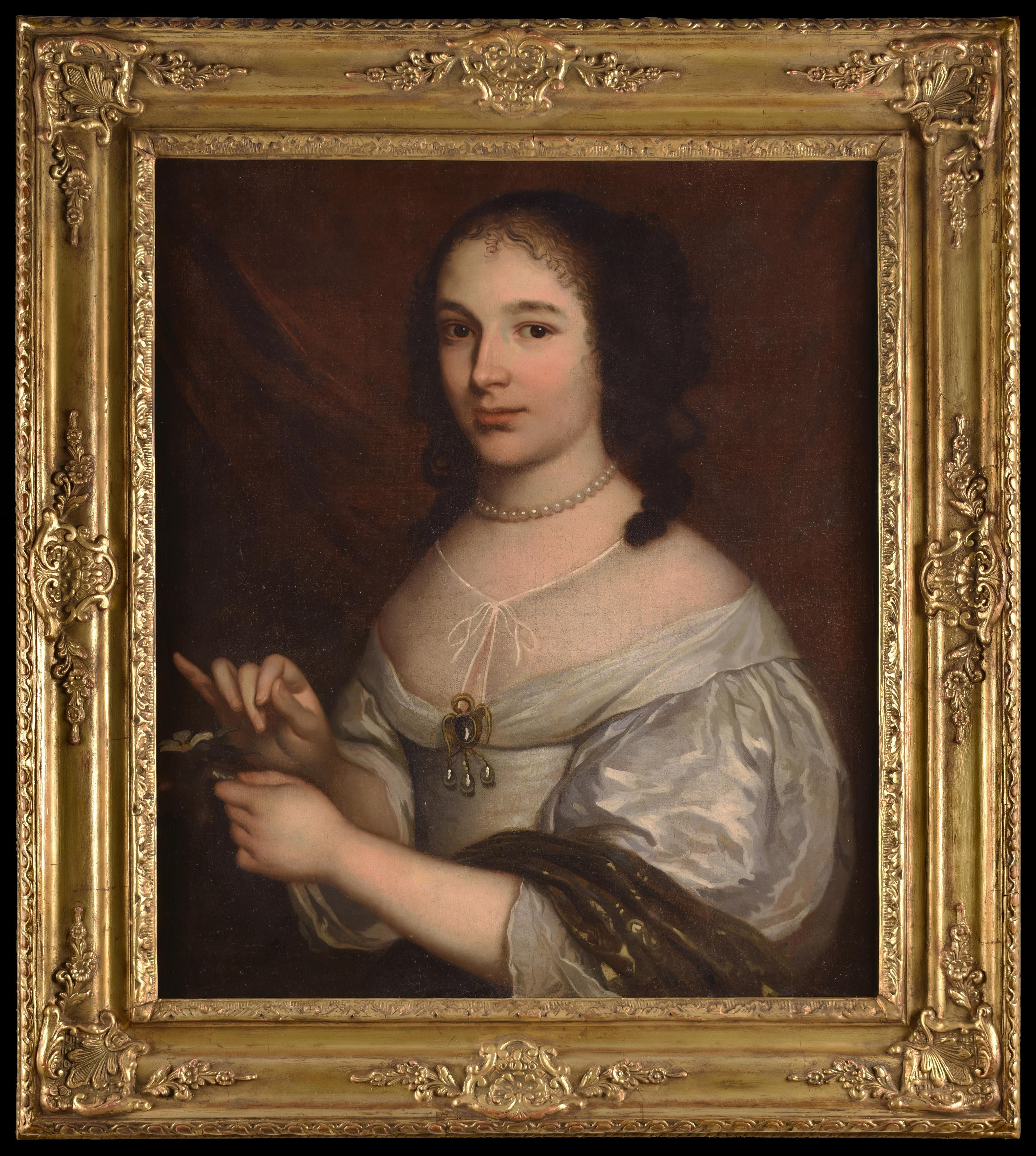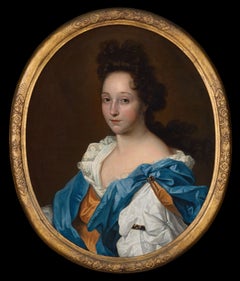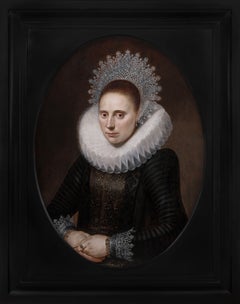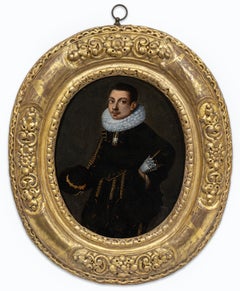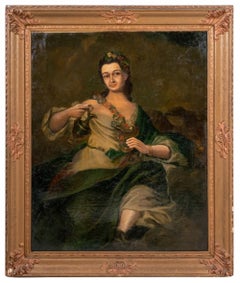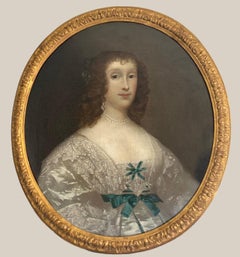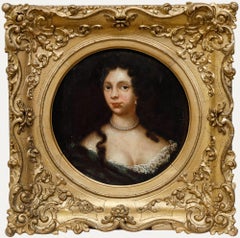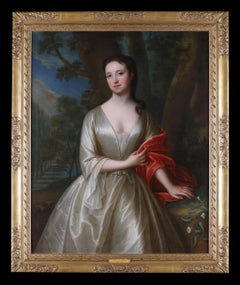Items Similar to Portrait of a Lady in Green Dress & Pearl Jewellery c.1660 Painting John Wright
Want more images or videos?
Request additional images or videos from the seller
1 of 11
Portrait of a Lady in Green Dress & Pearl Jewellery c.1660 Painting John Wrightcirca 1660
circa 1660
$14,594.98
£10,650
€12,424.95
CA$19,991.47
A$22,234.88
CHF 11,610.37
MX$270,574.88
NOK 148,282.08
SEK 139,062.43
DKK 92,732.20
Shipping
Retrieving quote...The 1stDibs Promise:
Authenticity Guarantee,
Money-Back Guarantee,
24-Hour Cancellation
About the Item
In this exquisite work, painted around the time of the Great Fire of London in 1666, a beautiful young woman is wearing a green dress over a white chemise and a russet-coloured scarf tied around her bosom. Prominently displayed is the accessory par excellence – pearls – an obligatory accompaniment in a female’s attire in portraits since at least the 1630’s. Here, they are used in her hair and as a single string around her neck. Although the sitter could afford pearls of her own, they were also common props in artist’s studios. The attire and hairstyle help to place the portrait chronologically between the years 1660 and 1670 when they were both in fashion. The feigned stone cartouche of acanthus foliage surrounding the sitter was a popular motif at this time and was used by a large number of artists in England.
The work is a fine example of English Baroque portraiture and it illustrates the painter's exceptional skill, individualised faces, and unique realism, particularly in the treatment of the face and the soft curls of hair that are defined with lightness and dexterity. Wright had acquired a considerable reputation as an artist and was painter at the English court; today he recognised as one of the foremost indigenous British painters of his generation.
John Michael Wright was one of only a handful of native-born painters to find favour amongst the top echelons of society. He introduced an Italian flavour into British painting, unlike all the other portrait painters in second half of the century. His realistic characterisations tend to reinforce Pepy’s critique that Lely’s portraits were ‘good but not like’ and, in 1662, when comparing the two artists “but Lord, the difference that is between their two works’.
He was born in London and initially trained in Edinburgh under the apprenticeship of George Jamesone, a painter of notable repute whose work was comparable to that of his English contemporaries in London. In the early 1640s, he went to Rome, and immersed himself in the study of some of the most distinguished painters of the time. By 1648, he had become a member of the Academy of St Luke, joining the ranks of other prominent artists such as Poussin and Velasquez. He returned to London in 1656, and two years later, a publication recognised him as one of the foremost artists in England.
Wright's distinctive individuality and success as an artist can be attributed, in part, to his varied artistic background and training. Over the course of more than a decade spent in Rome, along with his painting practice in France and presumably the Netherlands, Wright amassed a breadth of experience that surpassed that of any other painter in Britain during the latter half of the 17th century. This extensive experience lends an international quality to his works. Most of his subjects do not conform to any prevailing facial archetype; instead, they possess features that are uniquely and skilfully individualised, contrasting sharply with Lely's conventional portrayals of female beauty. Furthermore, Wright's colour palette, characterized by cooler and muted tones is quite different from Lely’s typically warmer hues. The women depicted in his portraits, who were primarily outside the courtly circles, embody a more traditional feminine demeanour marked by quiet and submissive modesty.
Measurements: Height 100cm, Width 85cm, 8cm Depth framed (Height 39.5”, Width 33.5”, 3” framed)
- Attributed to:John Michael Wright (1617 - 1694, British)
- Creation Year:circa 1660
- Dimensions:Height: 39.38 in (100 cm)Width: 33.47 in (85 cm)Depth: 3.15 in (8 cm)
- Medium:
- Movement & Style:
- Period:
- Condition:The condition is very good and can be hung and enjoyed immediately. The painting has passed a strict condition assessment by a professional conservator prior to going on sale.
- Gallery Location:London, GB
- Reference Number:1stDibs: LU1199115931042
About the Seller
5.0
Gold Seller
Premium sellers maintaining a 4.3+ rating and 24-hour response times
Established in 1998
1stDibs seller since 2019
44 sales on 1stDibs
Typical response time: 5 hours
- ShippingRetrieving quote...Shipping from: London, United Kingdom
- Return Policy
Authenticity Guarantee
In the unlikely event there’s an issue with an item’s authenticity, contact us within 1 year for a full refund. DetailsMoney-Back Guarantee
If your item is not as described, is damaged in transit, or does not arrive, contact us within 7 days for a full refund. Details24-Hour Cancellation
You have a 24-hour grace period in which to reconsider your purchase, with no questions asked.Vetted Professional Sellers
Our world-class sellers must adhere to strict standards for service and quality, maintaining the integrity of our listings.Price-Match Guarantee
If you find that a seller listed the same item for a lower price elsewhere, we’ll match it.Trusted Global Delivery
Our best-in-class carrier network provides specialized shipping options worldwide, including custom delivery.More From This Seller
View AllPortrait of a Lady in White Chemise, Russet & Blue Drapery c.1695, Oil Painting
By Harman Verelst
Located in London, GB
This lavish portrait, painted circa 1695, is an exquisite example of the type of portrait in vogue during the last quarter of the seventeenth century. It is evident that the artist ...
Category
17th Century Old Masters Portrait Paintings
Materials
Canvas, Oil
Portrait of a Lady in an Elaborate Ruff & Lace Coif c.1610-20, Dutch Old Master
Located in London, GB
This magnificent oil on panel portrait, presented by Titan Fine Art, is a splendid example of the sumptuous female portraits that were painted for members of the upper echelons of society during the early part of the 1600’s. The artist has rendered this portrait with meticulous attention to detail and the surface effects of the fine materials. The elaborate lace coif and cuffs are painstakingly delineated, as is the bold black damask, and sumptuous gold decoration of her skirt and stomacher, which is wonderfully preserved and quite remarkable considering the age of the work and the fact that darker pigments are particularly vulnerable to fading and wear. This work with its spectacular depiction of costume is of absolute quality, it can be rated as one of the best works in the artist’s oeuvre and as such it is an important and splendid example of Dutch portraiture.
The Dutch Golden Age of painting was a period in Dutch history, roughly spanning the 17th century, in which Dutch trade, science, military, and art were among the most acclaimed in the world. Dutch explorers charted new territory and settled abroad. Trade by the Dutch East-India Company thrived, and war heroes from the naval battles were decorated and became national heroes. During this time, The Dutch Old Masters began to prevail in the art world, creating a depth of realistic portraits of people and life in the area that has hardly been surpassed. The Golden Age painters depicted the scenes that their discerning new middleclass patrons wanted to see. This new wealth from merchant activities and exploration combined with a lack of church patronage, shifted art subjects away from biblical genres.
Dress was a key component in portraits, and the exuberant attire reiterates the incredible wealth of this woman. The sitter will have visited the artist’s workshop and inspected examples on display. They would have chosen the size and the sort of composition and on that basis negotiated the price – which would have also been determined by the complexity of the clothing and the jewels that were to be depicted, and by the materials to be used. When all was considered, this portrait would have cost the sitter (or her husband) a substantial sum.
The colour black was regarded as humble and devout yet at the same time refined and sophisticated and the most expensive colour of fabric to dye and to maintain. Citizens spent fortunes on beautiful black robes. Such uniformity must also have had a psychological side-effect and contributed to a sense of middle-class cohesion; the collective black of the well-to-do burgess class will have given its members a sense of solidarity. The colour was always an exciting one for artists and when this portrait was painted there were at least fifty shades of it, and as many different fabrics and accoutrements. Artists went to great lengths to depict the subtle nuances of the colour and the fabrics and textures and how they reflected light and it was an ideal background against which gold and crisp white lace could be juxtaposed to dramatic effect.
The sitter is either a married women or a widower as is evident by the clothing that she wears and the position, toward her right, it is highly likely that this portrait was once a pendant that hung on the right-hand side of her husband’s portrait as was convention at the time. She wears a vlieger which was a type of sleeveless over-gown or cape worn by well-to-do married women in the late 16th and early 17th centuries. Variations with short sleeves or high shoulder rolls are known. Sometimes sleeves were attached with aiglets, and often slits were made to allow belts or the hands to pass through. Three-piece vlieger costumes of this kind were standard items of clothing in portraits of the women of the civic elite in the period 1600-40 and was a variant of the Spanish ‘ropa’ and served as a trademark of well-to-do married burgher women. Girls and unmarried woman, including beguines, wore a bouwen (a dress with a fitted bodice and a skirt that was closed all round) instead. This clear distinction between apparel for married and unmarried women is clear not only from inventories and trousseau lists, but also from contemporary sources such as the Dutch Spanish dictionary published by Juan Rodrigues in 1634. In it, a bouwen is described as a ‘ropa de donzella’ (over-gown worn by a virgin) and a vlieger as a ‘ropa de casada’ (overgown worn by a married woman). It is striking how few women are depicted wearing a bouwen, unless they are part of a group, family or children’s portrait and it can therefore be assumed that independent portraits of unmarried women were seldom commissioned. It is also believed that the clothing worn in these portraits existed and were faithfully reproduced when cross-referenced with the few exact documents. These sources also demonstrate that clients wanted their clothing to be depicted accurately and with this in mind precious garments and jewels were often left in the painter’s studio.
The prominent white lawn molensteenkraag (or millstone ruff) is held up by a wire supportasse and was reserved only for the citizens that could afford this luxurious item that often required 15 meters of linen batiste. The fabulous wealth of this sitter is also evident by the elaborate lace coif and cuffs which have been exquisitely depicted; lace was often literally copied by artists in thin white lines over the completed clothing.
The gold bracelet with jewels is a type that was evidently fashionable as it is seen in a number of portraits during the 1610s and 1620. Clothing and jewellery were prized possessions and were often listed in inventories of estates and passed down from generation to generation. There were a great number of jewellers of Flemish origin working at all the courts and cities of Europe, competing with the Italians, and then the French, adapting themselves to the tastes and positions of their patrons and the raw materials available in the country where they worked. The fashion for jewels “in the Flemish style” succeeded that of the Italian style.
Cornelis van der Voort, who was probably born in Antwerp around 1576, came to Amsterdam with his parents as a child. His father, a cloth weaver by trade, received his citizenship in 1592. It is not known who taught the young Van der Voort to paint, but it has been suggested that it was either Aert Pietersz or Cornelis Ketel. On 24 October 1598 Van der Voort became betrothed to Truytgen Willemsdr. After his first wife’s death he became betrothed to Cornelia Brouwer of Dordrecht in 1613. In addition to being an artist, Van der Voort was an art collector or dealer, or both. In 1607 he bought paintings from the estate of Gillis van Coninxloo, and after an earlier sale in 1610 a large number of works he owned were auctioned on 7 April 1614. Van der Voort is documented as appraising paintings in 1612, 1620 and 1624. In 1615 and 1619 he was warden of the Guild of St Luke. He was buried in Amsterdam’s Zuiderkerk on 2 November 1624, and on 13 May 1625 paintings in his estate were sold at auction.
Van der Voort was one of Amsterdam’s leading portrait painters in the first quarter of the 17th century. Several of his group portraits are known. It is believed that he trained Thomas de Keyser (1596/97-1667) and Nicolaes Eliasz Pickenoy (1588-1650/56). His documented pupils were David Bailly (c. 1584/86-1657), Louis du Pré...
Category
17th Century Old Masters Portrait Paintings
Materials
Oil, Wood Panel
Portrait of Gentleman Blue & Cloak, Portrait of Lady, Fine Carved Gilded frames
Located in London, GB
Portrait of a Gentleman with Blue Cloak and Portrait of a Lady in Russet Dress c.1697
Thomas Murray (1663-1735)
These fascinating portraits are exquisite examples of portraiture in ...
Category
17th Century Old Masters Portrait Paintings
Materials
Oil, Canvas
Portrait of a Gentleman in Doublet & Ruff c.1595; Elizabethan oil on copper
Located in London, GB
Portrait of an Elizabethan Gentleman in a Black Doublet c.1595
Manner of Hieronimo Custodis (died c.1593)
Oil on copper
Unsigned
This exquisite oil on copper portrait, painted around 430 years ago, is a splendid survival from the Elizabethan era - the golden age in England’s history, when Queen Elizabeth I was on the throne. It is a time that is sandwiched between two golden ages of English renaissance culture, the reigns of Henry VIII and Charles I. This period produced a style of painting quite unlike that anywhere else in Europe and one that deserves serious assessment. Just a couple of years after our portrait was painted, English painting developed on another course, driven mainly by the artists Marcus Gheeraerts the Younger and Isaac Oliver; they depicted a new mood that was pervading Elizabethan and Jacobean society, which was that of romantic melancholy. Elizabethan painting...
Category
16th Century Old Masters Portrait Paintings
Materials
Copper
Portrait of a Gentleman, Doublet & White Ruff, Gloves Inscribed 1624, on panel
By Frans Pourbus the Younger
Located in London, GB
Titan Fine Art presents this exquisite oil on panel portrait depicting a handsome young gentleman in an exuberant black damask doublet. The pose, with one hand holding gloves and the other akimbo, was one that was well-established for gentleman of the upper echelons of society by the time this work was painted. The principle governing portraits at this time was the recording and defining in visual terms of the position of a sitter in society. In addition to brilliant and complex symbols of luxury, they often contained many symbolic elements too; the inclusion of gloves was often used in portraits that celebrated a betrothal as in ancient times gloves were used to seal a marriage contract.
The extraordinary costume of a black shimmering doublet, the brilliant white reticella ruff, and the cuffs edged with lace were immensely costly… this attire proclaims to every onlooker that this is a superior being. The rendering of the reticella lace ruff is exquisite and the artist has recorded the design that runs through the black damask fabric with meticulous attention to detail. The preservation of this black pigment is remarkable considering the age of the work. Black pigments are especially vulnerable to fade and wear over time partly due to environmental condition but also from unprofessional cleaning. This work is an exquisite example from the period.
According to the inscription in the upper right, the gentleman was in his 22nd year of age in 1624. The coat of arms, which is displayed without a crest, may be ‘blazoned’ in the language of heraldry, as: Sable on a Chevron between in chief two Roundels and in base a Billet [or possibly Square] Or three Martlets Sable. In plainer English this means a black (Sable) background, spanned by a gold (Or) chevron, above which are two golden solid circles (Roundels), and below which is a gold rectangle (Billet); on the chevron are three small black birds (Martlets). Martlets are a stylised form of heraldic bird, believed to be based on the swift, which are conventionally drawn with small tufts instead of feet. In Continental Europe it is also conventional for them to be drawn without beaks, as appears to be the case here. The birds in this instance also have a vaguely duck-like appearance.
Five families have been identified with very close armorial bearings to the one in our portrait. They are the (van) Houthem’s (of Brabant), the Prévinaire’s (of Flanders and Holland), and the Proveneer’s (of Liège) and it must be noted that the locations of these families also fit with the painting’s Flemish origins. However the French Grenières’s (of Île-de-France) and the Jallot’s (of Normandy) are the next closest matches and plausible matches, as Frans Pourbus had settled in Paris just a few years before our portrait was painted.
This painting has been assessed by a professional conservator prior to going on sale, and as thus, it can be hung and enjoyed immediately.
Frans Pourbus the Younger...
Category
17th Century Old Masters Portrait Paintings
Materials
Oil, Wood Panel
Portrait of a Gentleman in Grey Coat & White Cravat, Oil on canvas Painting
Located in London, GB
This exquisite work, presented by Titan Fine Art, is by the notable artist Hans Hysing, who was a noteworthy painter in England; it is significant in its q...
Category
18th Century Old Masters Portrait Paintings
Materials
Canvas, Oil
You May Also Like
Portrait of a Woman in Green Dress, Oil on Canvas, 19th Century
Located in Astoria, NY
Spanish School, Portrait of a Woman, Oil on Canvas, 19th century, depicting a woman with wine cup and ewer, unsigned, giltwood frame. Image: 41" H x 33" W; frame: 50" H x 42.5" W.
Category
19th Century Baroque Portrait Paintings
Materials
Canvas, Oil
17th century portrait of lady in an ivory silk gown and lace collar
By Cornelius Johnson
Located in Bath, Somerset
Circle of Cornelius Johnson (1593-1661), a 17th century portrait of a lady, bust-length oval, wearing an ivory silk gown with blue silk bows and lace c...
Category
Early 17th Century Old Masters Portrait Paintings
Materials
Canvas, Oil
$16,445 Sale Price
25% Off
Fine 18th Century Oil - Portrait of a Lady in Pearls
Located in Corsham, GB
A delightfully elegant 18th-century tondo depicting a lady in pearls. The subject is rendered in exquisite detail and is captured in fine attire, typical of the Georgian period. Beau...
Category
Early 18th Century Portrait Paintings
Materials
Oil
Portrait of a Lady possibly Frances Thynne, Lady Worsley 1673-1750 Oil on canvas
By Charles Jervas
Located in St. Albans, GB
Charles Jervas
Possibly Frances Thynne, Lady Worsley 1673-1750
Oil on Canvas
Picture Size: 50 x 40"
Outside Frame Size: 58 x 48"
1675 – 1739
Charles Jervas, who was born in Clonli...
Category
Early 1700s English School Portrait Paintings
Materials
Oil
$41,660 Sale Price
20% Off
Free Shipping
17th Century portrait oil painting of a lady
By Studio of Sir Peter Lely
Located in Nr Broadway, Worcestershire
Studio of Sir Peter Lely
Dutch, (1618-1680)
Portrait of a Lady
Oil on canvas
Image size: 29.25 inches x 24.25 inches
Size including frame: 37...
Category
17th Century Portrait Paintings
Materials
Canvas, Oil
Portrait of an elegant British lady with a white silk dress and a pearl necklace
Located in New York, NY
Portrait of an elegant British lady with a white silk dress and a pearl necklace. British School, close to Peter Lely.
Category
18th Century Portrait Paintings
Materials
Canvas, Oil
More Ways To Browse
The Green Lady
Antique Portrait Jewelry
Michael English
Artist Palette Jewellery
17th Century Pearl
St Luke
Scarf Display
Michael Wright
Antique Props
Single Baroque Pearl
Antique Hair Accessories
Michael Propper
Michael Good Jewelry
Antique Chemise
Wrights Antiques
St Michael Jewelry
Queen Mary Of Scots Portrait
Robert Agnew
